“Never underestimate the metamorphoses that the culinary arts can cause the taste of the potato to undergo.”
— Gustave Claudin, Trois Roses dans la rue Vivienne, 1877
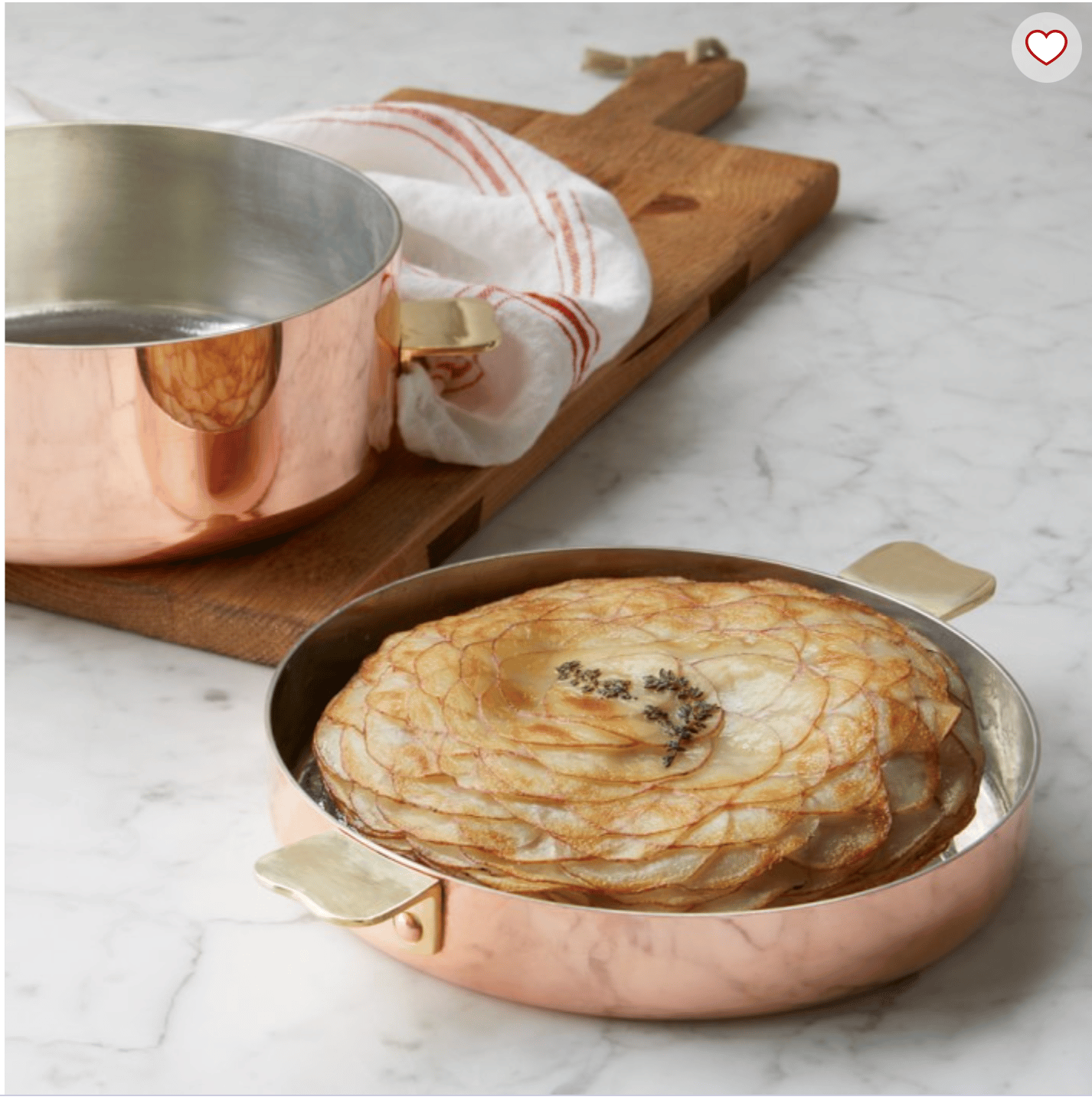 The premise of Pommes Anna is straightforward: thinly-sliced potatoes are layered in a round shallow pan, seasoned with butter and salt, then covered and baked. At the end of cooking the pan is flipped over and the galette [pancake] is turned out to reveal a golden-brown surface surrounding creamy steamed layers of potato. As Julia Child writes in Volume 2 of Mastering the Art of French Cooking, “the contrast of crusty exterior and tender, buttery interior is quite unlike anything else in potato cookery, and to many pommes Anna is the supreme potato recipe of all time.”
The premise of Pommes Anna is straightforward: thinly-sliced potatoes are layered in a round shallow pan, seasoned with butter and salt, then covered and baked. At the end of cooking the pan is flipped over and the galette [pancake] is turned out to reveal a golden-brown surface surrounding creamy steamed layers of potato. As Julia Child writes in Volume 2 of Mastering the Art of French Cooking, “the contrast of crusty exterior and tender, buttery interior is quite unlike anything else in potato cookery, and to many pommes Anna is the supreme potato recipe of all time.”
It is also one of the most straightforward recipes in French cuisine: potatoes, butter, salt, and pepper if desired. Though Pommes Anna is considered classically French, its origins are relatively humble: Wikipedia states that the recipe was invented in 1870 by Adolphe Dugléré, head chef at Cafe Anglais in Paris, as a late-night dish for the famed courtesan Anna Deslions (d. 1873). Anna was a celebrity of mid-19th century Paris and a particular favorite of Prince Napoléon-Jérôme Bonaparte (1822-1891), nephew of Napoleon I and cousin of Napoleon III. I draw your attention this evocative recollection of Anna published in 1891, almost twenty years after her death, in “The Demi-Monde of the Second Empire: Recollections of a Sybarite,” an essay-memoir in La Vie parisienne:
After the theatre, the most brilliant and highly rated couples met at the Café Anglais, in a vast gathering held in a reserved space by the preponderant coterie and which was and is still called, I believe, the Grande Seize [“cabinet particulier” number 16]…. Besides those [courtesans] of which I have already spoken, such as Barucci, Catinette, etc., one met there, first of all, the foundation, Anna Délion, a splendid, opulent and excellent girl, who not only came there in the evening, but still dined there almost every day and had long conferences with Ernest [“the pearl of butlers”], from which came the pommes de terre Anna, a succulent and since very popular dish, for which Ducléré [sic], owner of the Café Anglais, did not hesitate to build a special device, now in the possession of M. Renoul, the sympathetic bookseller on the Boulevard Montmartre.
She had been nicknamed Marie-Antoinette, this lovely Anna, because of the striking resemblance of her profile to that of the Queen. Miraculously beautiful she certainly was; tall, dark-haired, well-set, with a slight plumpness that stimulated desire, matte skin of dazzling whiteness, beautiful lascivious eyes, pretty hands, pretty feet, a nonchalant expression full of charm and seduction.
What had highlighted her was her known and displayed liaison with an imperial highness of high value and great prominence, who was very much in love with her, although the intellectual faculties of his object were terribly far from his own.
She had an overwhelming luxury, an unheard-of vogue, almost as many friends as lovers, and she died ruined, stripped of everything, in a small apartment in the rue Taitbout, to which a few sumptuous pieces of furniture, heartbreaking wrecks of her former splendor, gave an aspect of luxury and misery that clutched the heart….
I can easily imagine that the kitchen at Café Anglais would have been eager to accommodate the late-night appetite of such a star in the firmament of the Second Empire. But Anna’s heyday was the 1850s to 1860s; as noted above, she faded away and died in poverty in 1873. I would have expected Pommes Anna to have been created for her when she was still “a girl” out and about in society and not in 1870, quite close to the end of her life.
But in any event, the earliest mention of the terms pommes Anna or pommes de terre Anna that I could find in primary sources is in 1877. The restaurant scene in Paris in the 1870s was a competitive one, and already it appears that the dish had been adopted by other chefs. Take as an example the very earliest recipe I have found, published on July 7, 1877 in L’Estafette. The author, “Petit Vatel,” claims that the recipe was a specialty at the restaurant Champeaux:
Potatoes Anna — I owe this recipe, which was requested of me by one of the subscribers of L’Estafette, to the kindness of M. Vautrin, the excellent chef at Champeaux. The Pommes Anna is a specialty.
One must take potatoes from Holland, cut them into circles half a centimeter thick. Butter a somewhat thick copper pan, and dress the potatoes one by one in the pan; salt them and put butter on top; cover the pan with its lid, cook over low heat above and below and, when the potatoes have taken on a good color, serve them by simply overturning the pan to the plate.
I don’t consider this to be an actual recipe as much as it is an observation of someone cooking it, but the fundamentals are there: potatoes, butter, salt, heat “above and below” (more on this in a moment), and at the end, the flip.
Another literary appearance from 1877 is in a scene from the novel Trois Roses dans la rue Vivienne by Gustave Claudin (1819-1896). Here, the fictional Baron and Baroness de Vergy and the Count of Kérouan enjoy a meal prepared by the real-life Dugléré at the Café Anglais:
The baron had given carte blanche to the famous Dugléré, next to whom Vatel himself, that over-sensitive cook, would have been nothing but a vulgar scullion. The dinner, although very simple, was the same as that served in 1867, the year of the Exhibition, to the Emperor of Russia, when this sovereign, weary of official meals for sixty covers, wanted all at once delight his palate and spare his stomach.
After potage Germany and carpe à la Chambord,
… Then came épigrammes d’agneau aux pommes Anna. Never underestimate the metamorphoses that culinary art can cause the taste of the potato to undergo. Butter, pepper, and cooking modify it to such an extent that it becomes a new food.
Claudin claims that Pommes Anna had been served to the Emperor of Russia in 1867, three years prior to its apocryphal invention in 1870. In his day Claudin was a well-known bon vivant in Paris and it’s quite possible this event actually occurred, but I can’t find sources to verify it. In any case, it is clear that by 1877 Pommes Anna was an established dish across multiple restaurants in Paris.
The first complete and detailed recipe for Pommes Anna that I could find in online archives was published in 1889. Urbain Dubois (1818-1901) in his cookbook La cuisine d’aujordhui includes step-by-step instructions and, crucial to our interests, a helpful drawing of a small round pan.
Preparation of potatoes Anna (fig. 41). — It is the Café Anglais in Paris which has retained the privilege of serving these potatoes in the best manner.
It is above all the so-called Dutch variety that is best suited to this method. Choose long-shaped potatoes, peel them, turn them into a fat cork shape, slice them thinly using a machine; macerate them in cold water for a few minutes; drain them and thoroughly sponge them dry on a linen cloth.
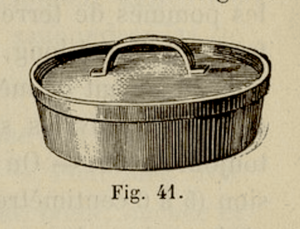 Hand-butter the inside of a thick copper timbale with a lid that fits exactly together; cover the bottom and the edge with an envelope of thin slices of potatoes, placing them one on top of the other. Quickly fill the empty timbale with the rest of the potatoes; salt them, lay them out in layers, and cover each layer with well-whipped butter, softened in a cloth; also cover the top layer with this same butter. Close the vessel with its lid, cook the potatoes for three quarters of an hour, either with hot ashes and fire around and above the timbale or simply in a gentle oven.
Hand-butter the inside of a thick copper timbale with a lid that fits exactly together; cover the bottom and the edge with an envelope of thin slices of potatoes, placing them one on top of the other. Quickly fill the empty timbale with the rest of the potatoes; salt them, lay them out in layers, and cover each layer with well-whipped butter, softened in a cloth; also cover the top layer with this same butter. Close the vessel with its lid, cook the potatoes for three quarters of an hour, either with hot ashes and fire around and above the timbale or simply in a gentle oven.
A quarter of an hour before serving the potatoes, remove the pan from the heat, cut the structure in four parts in the timbale itself, and invert each quarter by use of a palette [platter]; return them to the oven until the last moment, then invert them on a plate to serve them.
In the absence of a timbale, as shown in the drawing, a small sauté pan with a thick bottom and a suitable lid can be used.
I find a wealth of useful information in this recipe. First and foremost, by 1889 there was such a thing as a Pommes Anna pan in the form of a drum-like timbale with a well-fitted couvercle emboîtant. Auguste Colombié writing in June 1894 for Le Pot-au-Feu explains why this specialized pan was necessary.
We still use a special mold: the “pommes Anna mold.” It is a simple tinned copper timbale, low and very thick, with lid. 500 grams of potatoes will fill this mold, which measures 4 centimeters in height by 15 centimeters in diameter. This is enough to delight five to six people.
In the absence of this special mold, we take a sautoir or sauté pan because of their thickness. A Charlotte mold is not thick enough; inside, the potatoes would burn. In any case, you should hardly exceed the dimensions that I have just indicated, because you would risk that the potatoes do not cook inside.
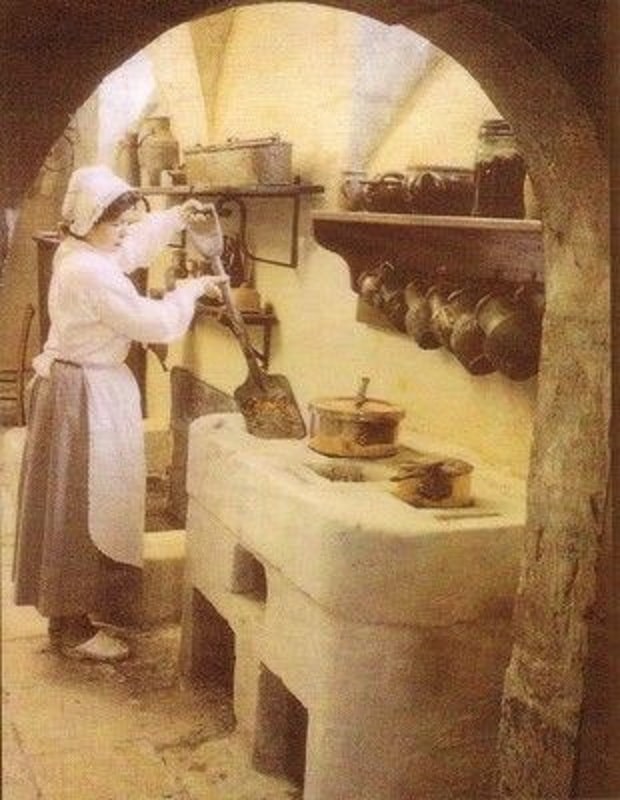 Back to the recipe by Dubois. The second thing I draw your attention to is the direction to cook the potatoes “either with hot ashes and fire around and above the timbale or simply in a low oven.” That’s why the lid of the timbale has a rim: it’s to hold the hot coals from a kitchen fire. At this moment at the end of the 19th century, some kitchens had installed cast-iron stoves but many others were still cooking over masonry potagers (such as the one shown at right) or in an open kitchen hearth.
Back to the recipe by Dubois. The second thing I draw your attention to is the direction to cook the potatoes “either with hot ashes and fire around and above the timbale or simply in a low oven.” That’s why the lid of the timbale has a rim: it’s to hold the hot coals from a kitchen fire. At this moment at the end of the 19th century, some kitchens had installed cast-iron stoves but many others were still cooking over masonry potagers (such as the one shown at right) or in an open kitchen hearth.
Thirdly, this recipe calls for not just one but two inversions. Why? My guess is that the second flip was to return the best-browned portion of the galette to the top.
Finally, as both Dubois and Colombié note, the timbale was not the only vessel for Pommes Anna; one could use a sauté pan as long as it had a well-fitting cover. But the French chaudronniers were never ones to miss the chance to develop a specialized product. For a period of time, two versions of the Pommes Anna pan were available: the drum-like timbale as well as an alternate version with a stick handle.
Dehillerin in 1896 offered only this alternate style, which they called the Casserole pour pomme Anna. (This 1896 Dehillerin catalog is an exciting new addition to the site’s Library, for which I extend sincere thanks to reader Kris P.!) To my eye the pan is nearly indistinguishable from a sauté, but note how the shaft of the handle projects away from the baseplate. I suspect this was done to accommodate the overhang of the cap-style lid. If you see an antique-era sauté pan with this unusual set-back handle, it may be a casserole pour pomme Anna pan that has lost its lid.
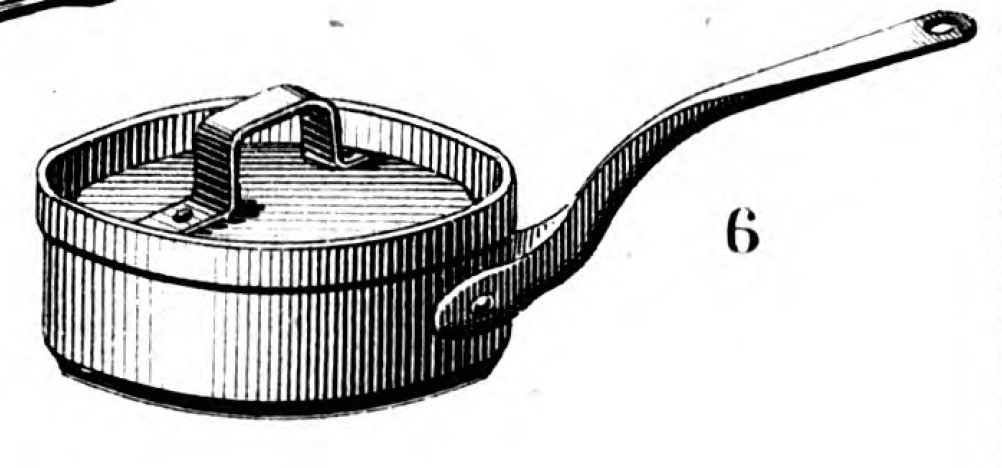
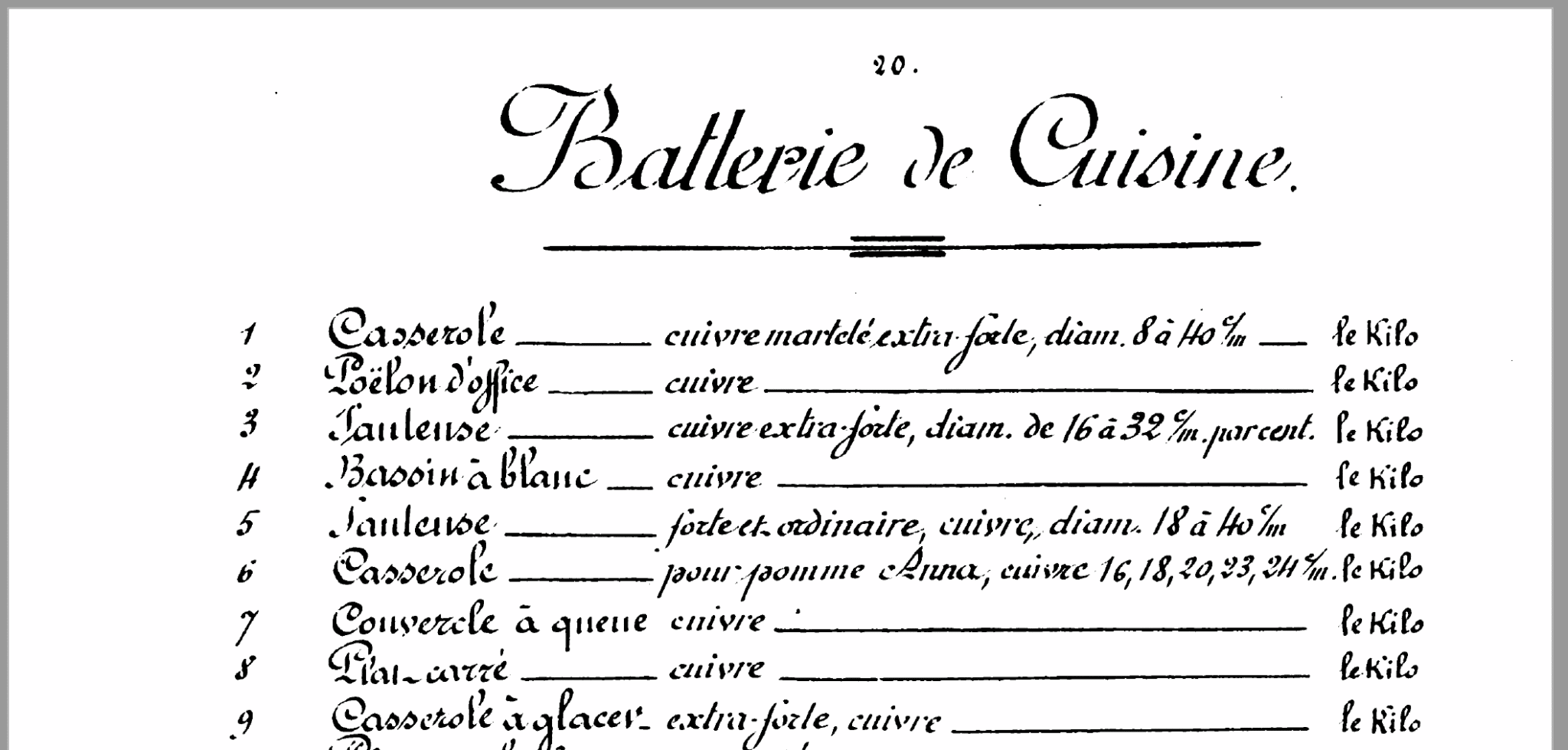
Fifteen years later in 1914, Gaillard offered both variants, as shown below. In Gaillard’s terminology, each pan is a casserole Pomme-Anna but one has a queue [tail] and the other has oreillons fondus [little metal ears]. (Note again how the shaft of the handle of the casserole style curves away from the baseplate to create lid clearance.) But I spot an important evolutionary change: while the lid of the casserole retains the raised rim, the lid of the timbale is a simple top-handled cap.
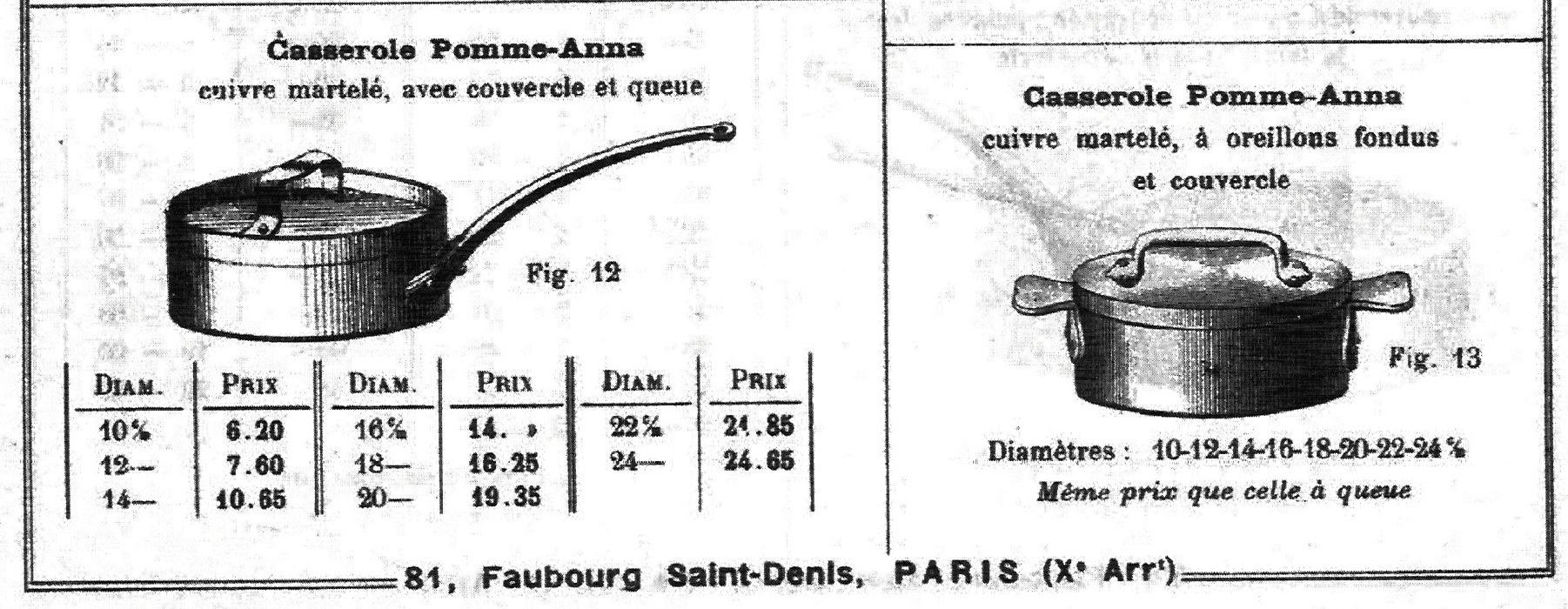
What significance is there, if any, in the different lid on these two pieces?

My initial hypothesis is that these two pan configurations were intended for different types of stoves. The casserole with its long handle would be more convenient for potager or hearth cooking, while the compact timbale could more easily be tucked inside the cramped compartment of a cast-iron stove. The casserole therefore retains the rimmed lid to hold hot coals whereas the timbale no longer needs that feature.
But in counter-argument, I draw your attention to the Pommes Anna pans in the Jacquotot catalog of 1925, shown at right. The same two pans appear with the exact same drawings as in Gaillard in 1914. This is the pitfall of catalog-based research: if drawings were re-used across manufacturers from one decade to the next, how can we be sure that the details remain correct and specific to each marque at that moment in time?
I am tracking with such unnatural attention the demise of the casserole style because I believe this is also an indicator of the transition of French kitchens from open-fire cooking (to include potagers that used hot coals from a hearth fire) to enclosed ovens. To see a stick-handled, rimmed-lid piece as late as 1925 (and even in 1914) seems like an anachronism to me — I would have expected most Parisian households to have installed stoves by then, rendering superfluous the long handle and rimmed lid. Readers, I would welcome your thoughts on this.
By Gaillard’s 1956 catalog, the timbale was the only version for sale. It seems the casserole had finally gone extinct.
There was one more evolutionary step to come. Sometime after that 1956 catalog, the lid’s handle migrated from the top to become two side-mounted oreille handles aligned with the handles of the base. (See the examples in Lamalle’s 1988 catalog, shown below at right.) This is a functional improvement because when the dish is ready to be turned out for serving, the chef can simply clamp lid and base together and invert them together. The galette slides into the lid from where it can be sliced and served to guests. This addresses the trickiest part of the preparation of Pommes Anna, which is to get the thing out of the pan without tearing or deforming it.
I do not have information about who made this design change, but if I had to guess I’d say it was Mauviel.
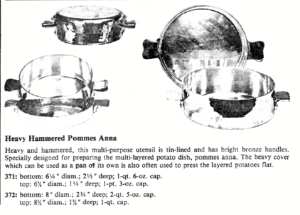
Mauviel supplied copper cookware to Gaillard after WWII, and the Gaillard catalog of 1956 suggests that the top-handled timbale was still in production in the mid-1950s. This was a threshold moment. Chuck Williams traveled to Villedieu in 1959 to meet Armand Mauviel and convince him to import copper to the United States so that Chuck could sell it at a cooking store he planned to open called Williams-Sonoma. That was the beginning of a close business partnership that persists to this day. Over the decades, Williams-Sonoma has given Mauviel design feedback for products that would be more friendly to the U.S. market (to include multiple “Williams-Sonoma exclusive” copper cookware lines). I can easily imagine (but have no evidence for!) Chuck Williams — a pragmatic cook and canny marketer — suggesting to Armand Mauviel that shifting the Pommes Anna lid handles to the side would make it much easier for amateur cooks to turn out a beautifully intact galette.
Below, from my own collection, are examples of the early modern top-handled timbale as well as a late-modern side-handled version that is so familiar to us.
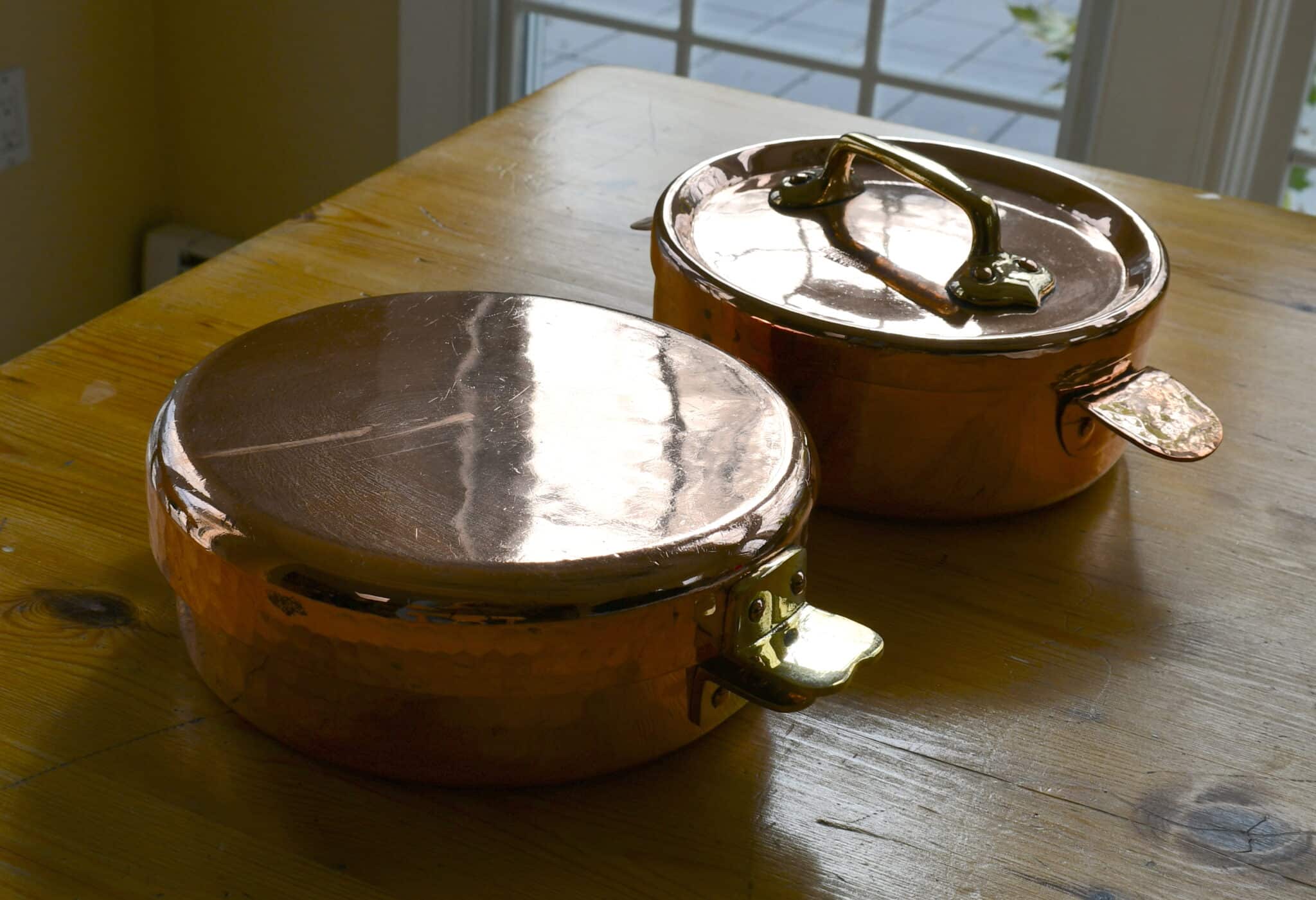
| Type | Tin-lined side-handled Pommes Anna pan | Tin-lined top-handled Pommes Anna pan |
| French description | Timbale à Pommes Anna aux oreillons | Timbale à Pommes Anna avec anse |
| Dimensions | 20cm internal diameter by 8cm tall (7.9 by 3.1 inches) | 19cm internal diameter by 9cm tall to plane of lid (7.5 by 3.1 inches) |
| Thickness | 2mm at rim | 1.8mm at rim |
| Weight | 1550g (3.4 lbs) pan body only; 2874g (6.3 lbs) with lid | 2070g (4.7 lbs) pan body only; 2982g (6.6 lbs) with lid |
| Stampings | Gaillard Paris | E. DEHILLERIN 18 RUE COQUILLIÈRE PARIS |
| Maker and age estimate | Mauviel for Gaillard, 1970s-1990s | Dehillerin, 1900s-1910s? |
| Source | Private sale | Private sale |
The Dehillerin is a pre-WWII piece, and the Gaillard (made by Mauviel) is effectively identical to thousands of similar pieces produced from the 1960s to the early 2000s. Note the difference in weight distribution between the pan and lid of each piece. The body of the modern-era Gaillard makes up 53% of the total mass, an almost equal distribution of weight between body and lid, while the body of the antique Dehillerin accounts for 69% of the total mass. The lid of that modern-era pan is really a second small pan in and of itself.
One additional detail to notice is that the top-handled lid is slightly inset. I don’t think this is a vestigial rim but rather a ridge to catch and redirect condensation on the underside. This feature helps keep moisture from escaping to drip down the outside of the pan. (I see the same inset around the rims of early modern daubières as well for the same reason.) In contrast, the modern-era lid needs to be perfectly flat so that it can function as a serving platter.
But is this design change truly an improvement? Do the paired handles really make it easier to turn out the galette? Does the convenience of the flat serving lid justify the loss of the condensation trap?
There is only one way to know for sure.
Haphazard Pommes Anna with VFC
I’ll start off by saying that yes, indeed, I did successfully cook this dish, but I made a few mistakes along the way that I would seek to correct the next time around. That said, a dish of hot potatoes, butter, salt, and pepper can’t go too far astray. While the results of my efforts would not have passed muster in a commercial kitchen, I certainly scarfed it down with enjoyment.
But you, dear reader, would be wise to consider the narrative below as a cautionary tale.
After some study of various recipe options, I chose to follow the guidance from volume 2 of Julia Child’s Mastering the Art of French Cooking. She devotes four pages to the dish and I will not attempt to reproduce all of that information here. The fundamentals are the same as those in the earlier versions of the recipe but Julia, as usual, contributes several useful tips along the way.
We begin, as we must, with potatoes.
Both the 1877 and 1889 recipes call for Dutch potatoes, by which is likely intended a potato of creamy or waxy texture, what we in the U.S. would call a red or yellow “boiling” potato rather than a russet or white floury-textured “baking” potato. I suppose one could use any sort of potato but a waxy variety will likely slice cleanly and hold its shape better than a floury one.
I peeled mine, somewhat incompetently, but managed to get most of the skin off. Julia counsels the cook to trim the potatoes into oval shapes (Dubois calls the intended results “fat corks”) so that the slices are of uniform size. Naturally, I ignored this and left mine in their irregular lumpen shapes.
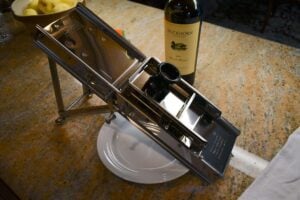 The next step was to slice them. This is the sort of task for which the mandoline was invented. I owned a plastic hand-held mandoline for several years but seldom if ever used it out of fear of cutting myself on it. I overcame this reluctance in order to slice up some fennel for a luncheon but inevitably managed to cut my thumb rather severely mere minutes before the guests were to arrive. (Lesson learned: Listen to your fears.) I threw away that mandoline in a fury and went on eBay to find myself the Cadillac of vintage mandolines: le véritable mandoline Bron, modèle 20638, avec chariot. It arrived in its original 1980s era box partially wrapped in tractor paper (which I now deeply regret throwing away). This contraption requires several minutes of unpacking, arranging of feet, and adjustments of various levers, but when deployed it performs beautifully and, most importantly, keeps my fingers well away from harm.
The next step was to slice them. This is the sort of task for which the mandoline was invented. I owned a plastic hand-held mandoline for several years but seldom if ever used it out of fear of cutting myself on it. I overcame this reluctance in order to slice up some fennel for a luncheon but inevitably managed to cut my thumb rather severely mere minutes before the guests were to arrive. (Lesson learned: Listen to your fears.) I threw away that mandoline in a fury and went on eBay to find myself the Cadillac of vintage mandolines: le véritable mandoline Bron, modèle 20638, avec chariot. It arrived in its original 1980s era box partially wrapped in tractor paper (which I now deeply regret throwing away). This contraption requires several minutes of unpacking, arranging of feet, and adjustments of various levers, but when deployed it performs beautifully and, most importantly, keeps my fingers well away from harm.
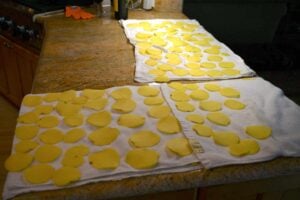 I worked through my bowl of potatoes with dispatch. Julia suggests a consistent thickness of 1/8 inch (3mm), which I considered more of an aspiration than a hard requirement.
I worked through my bowl of potatoes with dispatch. Julia suggests a consistent thickness of 1/8 inch (3mm), which I considered more of an aspiration than a hard requirement.
All the recipes for Pommes Anna note the importance of removing moisture from the slices, so I blotted them and laid them out on a kitchen towel to dry.
The next task was to clarify some butter. Julia’s recipe does not specify what type but I chose unsalted, figuring I would add plenty of seasoning salt along the way. A petite 12cm saucepan was perfect for melting one 8-ounce (227g) package of butter.
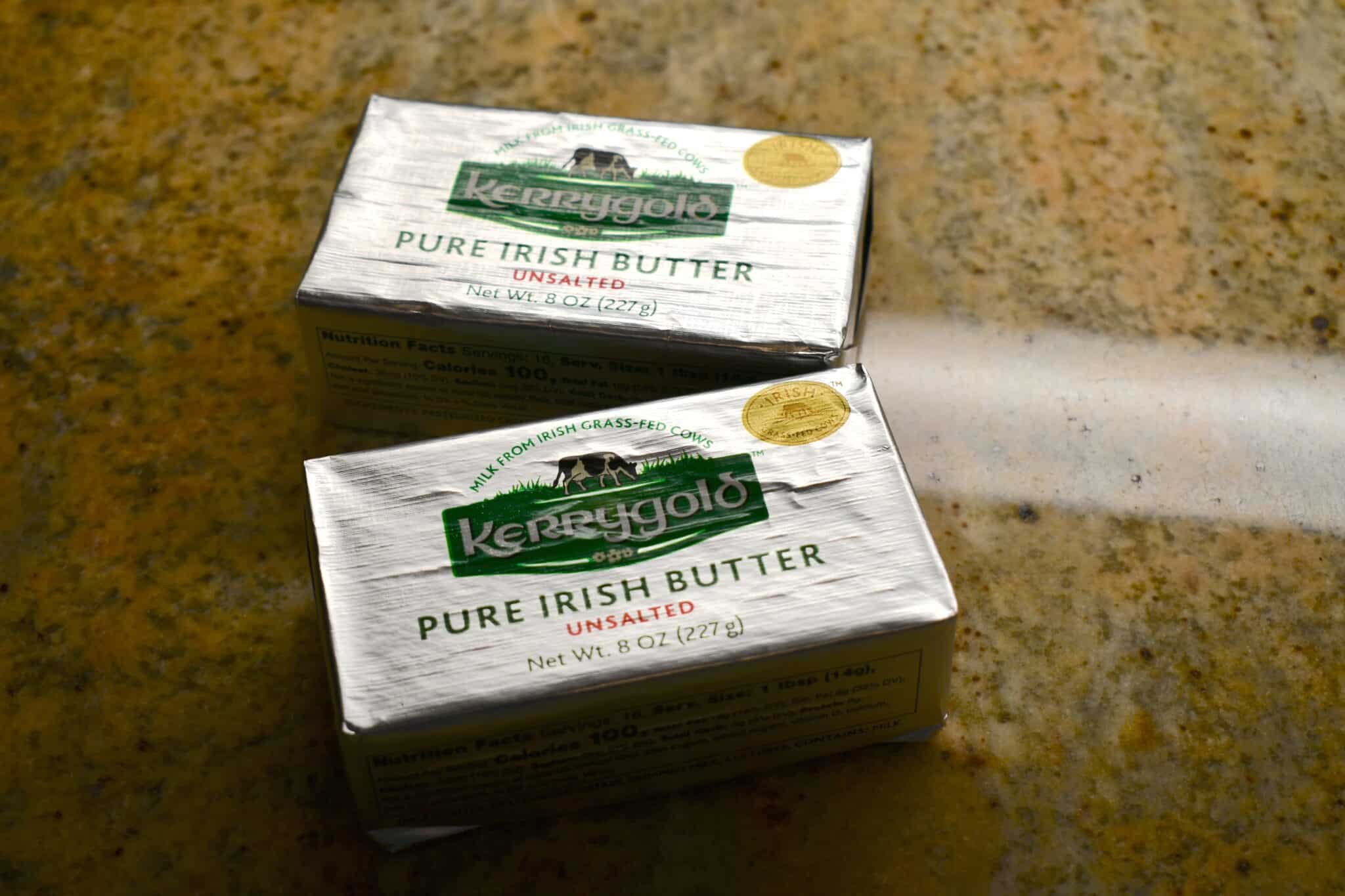
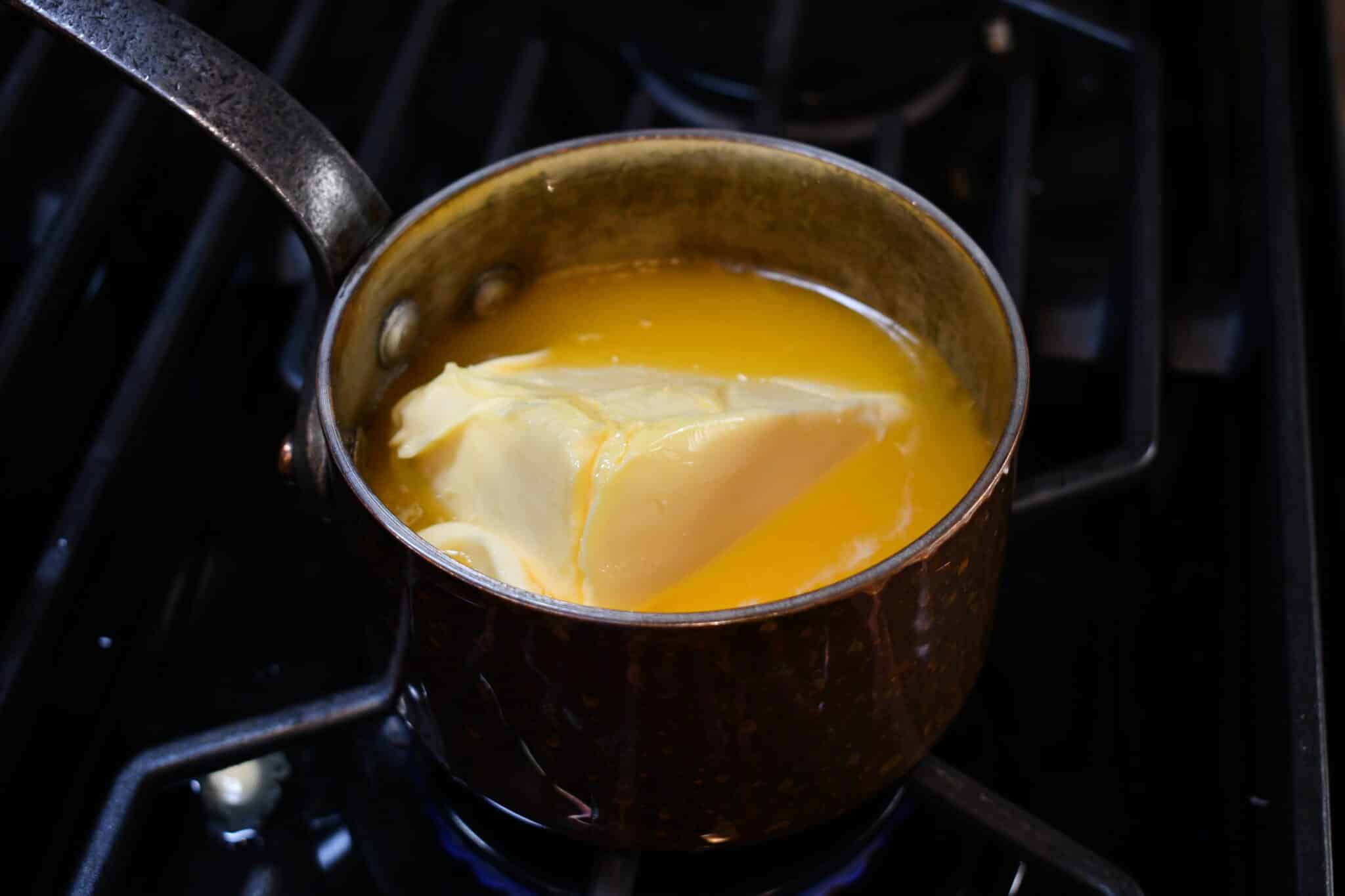
Then came the assembly of the galette.
It is worth noting that Julia, ever the pragmatist, counsels not to use a Pommes Anna pan at all. She notes that “its absolutely vertical sides, 3-inch depth, and frequent tendency to sticky-bottom troubles make it less easy to use than other possibilities” such as a skillet or casserole dish with slightly angled sidewalls.
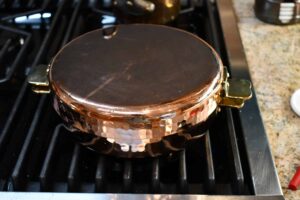 But the most important quality, according to Julia, is that the pan heat evenly: “The essential is to have a material that will get thoroughly hot all over, to brown and crust the outside of the potatoes.” Copper will certainly do this but the illustrations for Julia’s recipe show a cast-iron skillet (for which the cook will also need a well-fitting lid).
But the most important quality, according to Julia, is that the pan heat evenly: “The essential is to have a material that will get thoroughly hot all over, to brown and crust the outside of the potatoes.” Copper will certainly do this but the illustrations for Julia’s recipe show a cast-iron skillet (for which the cook will also need a well-fitting lid).
My objective for this exercise was to test a copper Pommes Anna, and so I used my 20cm pan.
With the potatoes sliced and dried and the clarified butter, salt, and pepper standing at the ready, the next step was to lay out the potatoes into the pan. Here Julia’s directions differ from the traditional recipe and it’s worth considering why.
The key to this dish is that the bottom layer of potatoes must brown thoroughly so that when it is inverted for serving the surface is invitingly crisp and flavorful. The recipes of the antique era offer various suggestions: uncover the pan halfway through the bake; flip the galette onto a platter and finish it with a short bake; cut the galette into pieces, remove them, turn them, replace them into the pan, and finish with a short bake; and so forth.
Julia suggests another means to achieve the same result without interrupting the cooking to man-handle the potatoes (and risk tearing any insufficiently-browned potatoes on the surface). She directs you to pre-heat the pan on the stovetop and lay the potato slices into an already-hot pan, where they will begin cooking immediately and reduce or eliminate the need for direct exposure later in the cooking process.
So that is what I did. I heated the pan with some butter and, when it reached a decently hot temperature, I began laying out the slices. There is some art to this. The goal is evenly distributed layers, and Julia’s technique is to work clockwise and then counter-clockwise, layer by layer. Each layer gets a dose of butter, salt, and pepper.
As you can see below, my technique rapidly deteriorated.
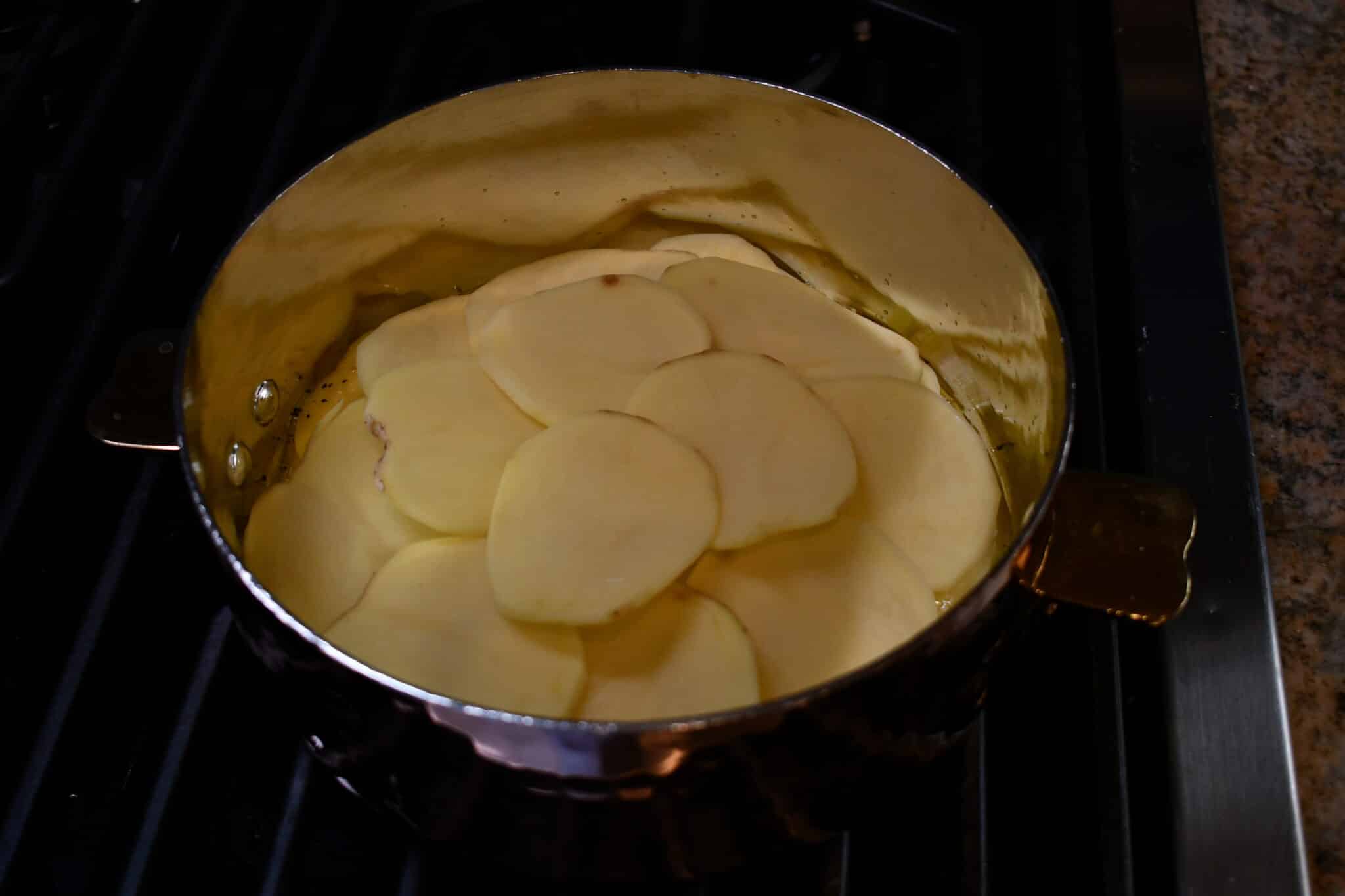
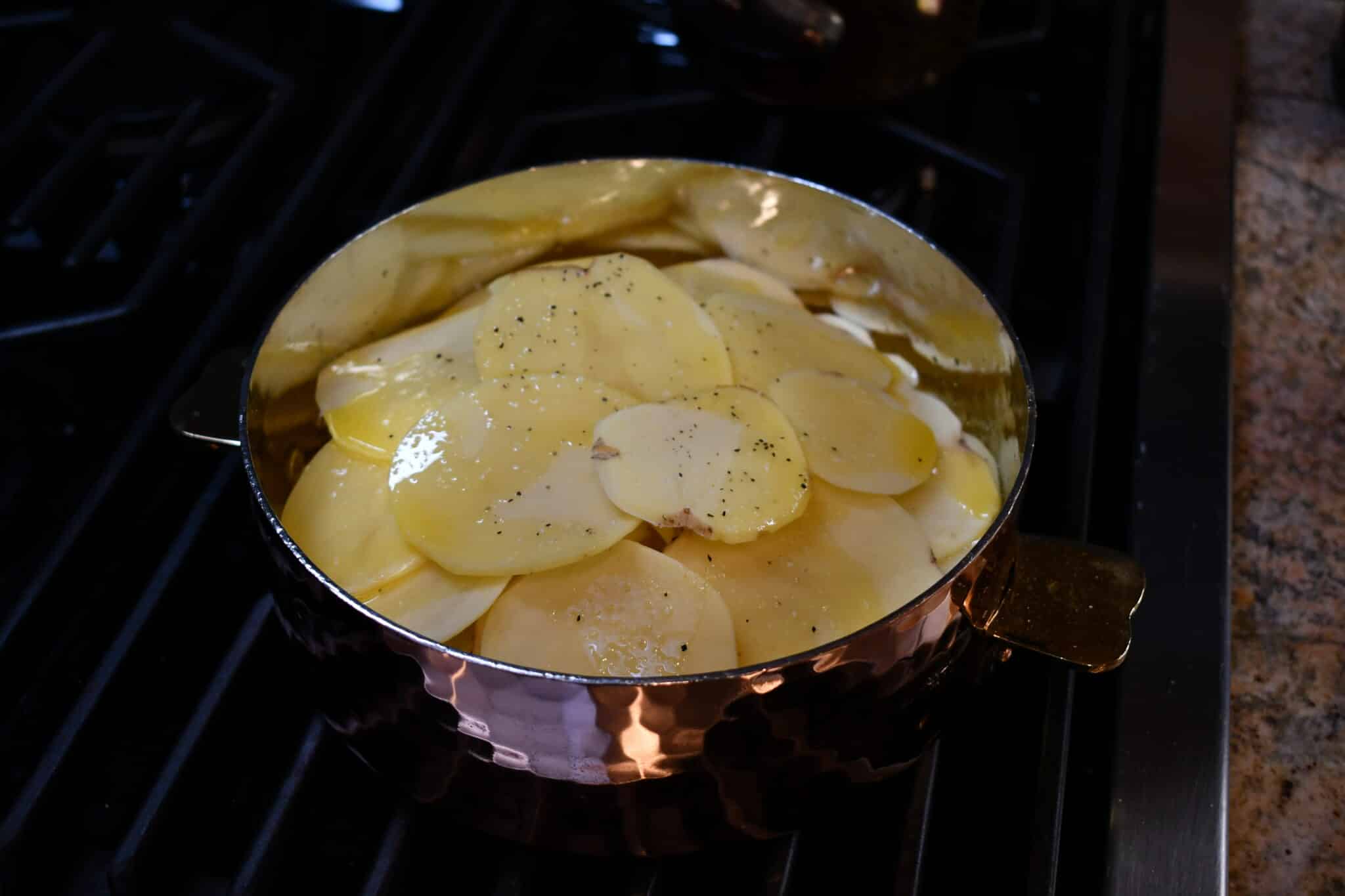

This is where the negative consequences of the uneven shape and thickness of my slices became manifest: the pieces overlapped irregularly and the layers formed a pronounced dome shape instead of a nice flat surface. Julia anticipates a half-inch or so of doming and instructs the cook to compress the surface with the underside of a small saucepan. (Charles Lamalle noted that “the heavy cover [of the Pommes Anna pan]… is also often used to press the layered potatoes flat” but I cannot for the life of me see how that could work.) My butter warmer saucepan was the perfect size for this (and the only thing within reach) and I was able to flatten the stack a little bit.
I put the lid on the pan, set it on a small baking sheet, and tucked it into a pre-heated 450°F (232°C) oven. (Yes, 450°F is higher than the melting point of tin, but in this case the pan is filled with heat-absorbing food. It would take quite some time — well beyond the cooking period — for the inner surfaces of the pan to reach that temperature.)
After 20 minutes, Julia advises removing the lid, pressing down once again with the saucepan, and baking another 20 to 25 minutes. Here is my Pommes Anna at that halfway point. I have just pressed the surface again and put it back into the oven to bake uncovered.
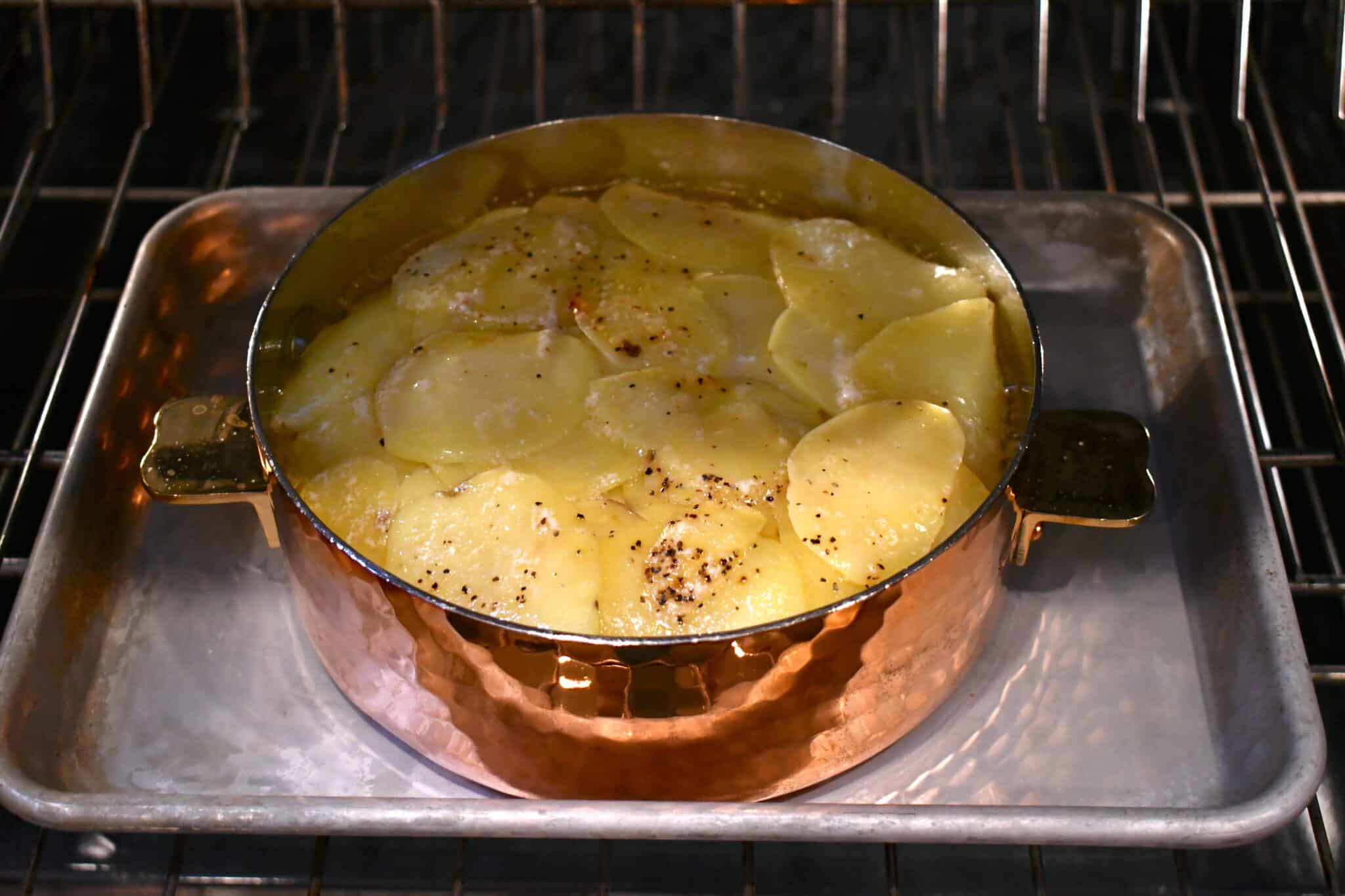
And finally, 25 minutes later, here is the cooked dish. The surface is nicely browned and the hot butter is bubbling at the edges.

And now for the moment of truth: draining the excess butter and inverting the potatoes into the lid for serving. I moved the hot pan to my stovetop and re-covered it with its lid. I aligned the side handles, gripped the lid and base together, and turned them sideways for a few moments to drain butter into the baking sheet. Once the flow of butter slowed to a drip, I completed the flip, set the pan upside-down on the stovetop, and lifted away the bottom piece.
Voilà! Haphazard Pommes Anna!
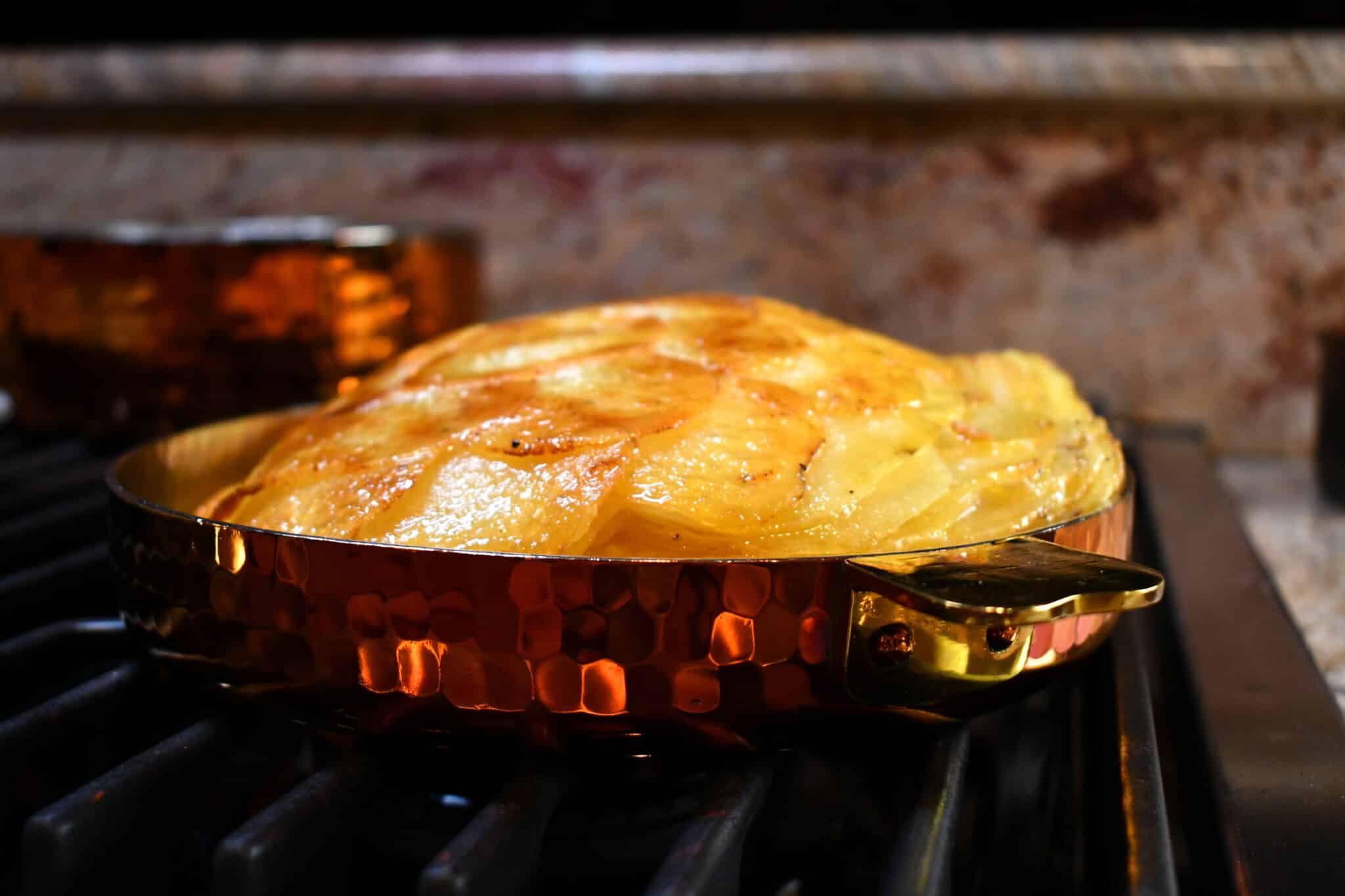
I am sure that experienced cooks who have made this dish before are grimacing with dismay because cosmetically, this is a disaster. It’s still domed! It’s not evenly browned! The arrangement of layers is not a well-formed stack but a lopsided pile! My creation bears only a passing resemblance to the delicate confection shown in the Williams-Sonoma catalog at the top of this post.
But that’s fine with me. This was an experiment and it was delicious. But here’s how I’d improve it the next time.
Consistent shapes. Yes, I see now why trimming the potatoes makes sense. I could have done a better job with the layering if the pieces had been the same size and shape, and I think I would have been able to achieve better placement out to the very edges of the galette so that the sides were not so sloping. Next time I will think of the Pommes Anna pan as a mold and try to fill up the volume as completely as I can.
Thinner and more consistent slices. I’m not really certain how thick my slices were, but they were too thick. I’m not very experienced with my mandoline and could use some more practice with it.
Taking the pressing-down step more seriously. I assumed this was a superfluous cosmetic step and I performed it half-heartedly, but I see now the difference it would have made. Pressing down more firmly would have helped the galette assume a better cake-like shape.
Slow down! I am not sure why I felt I needed to lay out the potato slices as quickly as possible. In my defense, Julia’s technique of pre-heating the pan means that the potatoes and butter started sizzling as I was working, and my brain interpreted this as a “hurry up!” cue. But that’s not the case at all — the potatoes need lots of time to cook and a few minutes on the stovetop can only help them along. I should have worked more deliberately.
Bake longer. I followed Julia’s directions for a total of 45 minutes of baking time, but I think I could have left it in for at least another ten minutes. I think the bottom (which became the top surface) could have browned some more.
This was my first time making Pommes Anna, and so I don’t have a prior experience for comparison, but I did find the pan very easy to use. The side handles of the lid and base clamped securely together and I didn’t feel uncomfortable draining out all that hot butter. And the flip — which seemed to me to be the trickiest part of the whole thing — was easy. I do wonder at Julia’s statement earlier that copper pommes Anna pans have a “frequent tendency to sticky-bottom troubles.” My experience was that the potatoes slipped out easily and did not stick at all to the tin. Perhaps the fresh tin of my pan released more perfectly than Julia experienced.
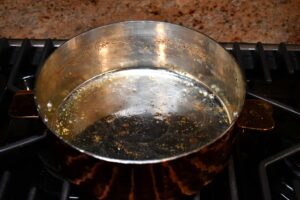 As a final note, I’d like to mention that cleanup was quite easy. At right is a photo of the pan base after cooking. This dish as I prepared it has no food acids in it and so the tin remains bright. I was able to wash the pan and lid with soap and water and the baked-on remnants came away easily.
As a final note, I’d like to mention that cleanup was quite easy. At right is a photo of the pan base after cooking. This dish as I prepared it has no food acids in it and so the tin remains bright. I was able to wash the pan and lid with soap and water and the baked-on remnants came away easily.
Thank you for following along with this very long post! If I can make Pommes Anna, you can probably do it much better than I did. If you don’t have a timbale, try it with a sauté pan or, as Julia Child recommends, a cast iron skillet. Just make sure you have a well-fitting lid to keep the steam and heat inside.
Postscript
The appearance of the nom de plume “Petit Vatel” and then “Vatel, that over-sensitive cook” in two separate sources for this post mark the threshold of a rabbit hole down which I hope you will accompany me. (Fair warning, this is not a happy tale.)
François Vatel was a 17th century chef and namesake of many “Petit Vatel” restaurants across France. Born in 1631, Vatel apprenticed as a pastry chef and rose through the ranks to become head chef at the palace at Vaux-le-Vicomte, then the residence of the wealthy Marquis Nicolas Fouquet. A lavish spread that Vatel orchestrated in 1661 for the visit of King Louis XIV backfired when the King became jealous of Fouquet’s wealth and extravagance. Fouquet was arrested, tried, and imprisoned for life, and Vatel fled to England. (The King subsequently absorbed Vaux-le-Vicomte into his own holdings and retained the household but Vatel was apparently too frightened to wait for a job offer.)
Vatel found a new employer in Louis II of Bourbon-Condé, cousin to Louis XIV and who was also skulking in exile in England. After a couple of years of political machinations, Louis II returned to France and in 1663 Vatel was installed as head chef at the palace of Chantilly. Louis II was desperate to win the favor of Lous XIV once again and after several years of renovations to the property, he announced a lavish three-day feast in honor of the King’s visit in April 1671. Vatel was in charge of all the arrangements and likely saw this as an opportunity to redeem himself after his embarrassing fiasco in 1661.
Unfortunately, the King’s enormous retinue arrived with 75 additional guests, throwing Vatel’s planning into chaos. Early in the morning of Friday April 24, Vatel waited at the castle gates in growing dismay as only two baskets of an enormous order of fish had arrived. Seeing that the evening’s grand dinner was ruined, Vatel turned to his second-in-command and announced, “Sir, I will not survive this affront. I have my honor and reputation to lose.” Vatel returned to his room, wedged his sword in the doorjamb, and ran himself through three times, dying right about the same moment that the rest of the complete fish order was arriving at the castle gates.
Despite his tragic suicide Vatel is seen as a hero to the professional cadre of chefs. Though he succumbed to the tremendous pressure of his career, his death also prompted acknowledgement of those unreasonable circumstances. After Vatel’s death came the creation of the concept of “catering” with dedicated supply agreements that could accommodate large-scale events and which would have averted his despair.
Sources
La Vie parisienne : moeurs élégantes, choses du jour, fantaisies, voyages, théâtres, musique, modes / par Marcellin, 03 janvier 1891. Bibliothèque nationale de France, département Philosophie, histoire, sciences de l’homme, FOL-LC13-81
Trois Roses dans la rue Vivienne / Gustave Claudin ; G. Charpentier (Paris), 1877. Bibliothèque nationale de France, département Littérature et art, 8-Y2-510.
L’Estafette (1876-1914), 7 juillet 1877. RetroNews, le site de presse de la Bibliothèque nationale de France.
La Cuisine d’aujourd’hui, école des jeunes cuisiniers, service des déjeuners, service des dîners, 250 manières de préparer les oeufs… par Urbain Dubois. E. Dentu (Paris), 1889. Bibliothèque nationale de France, département Sciences et techniques, 8-V-21299
Le Pot-au-feu : journal de cuisine pratique et d’économie domestique, 1894. Bibliothèque nationale de France, département Arsenal, 4-JO-10629
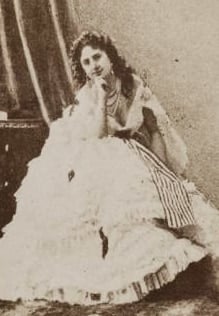
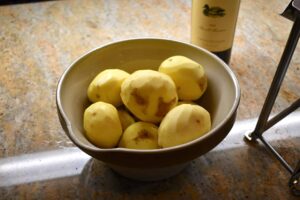
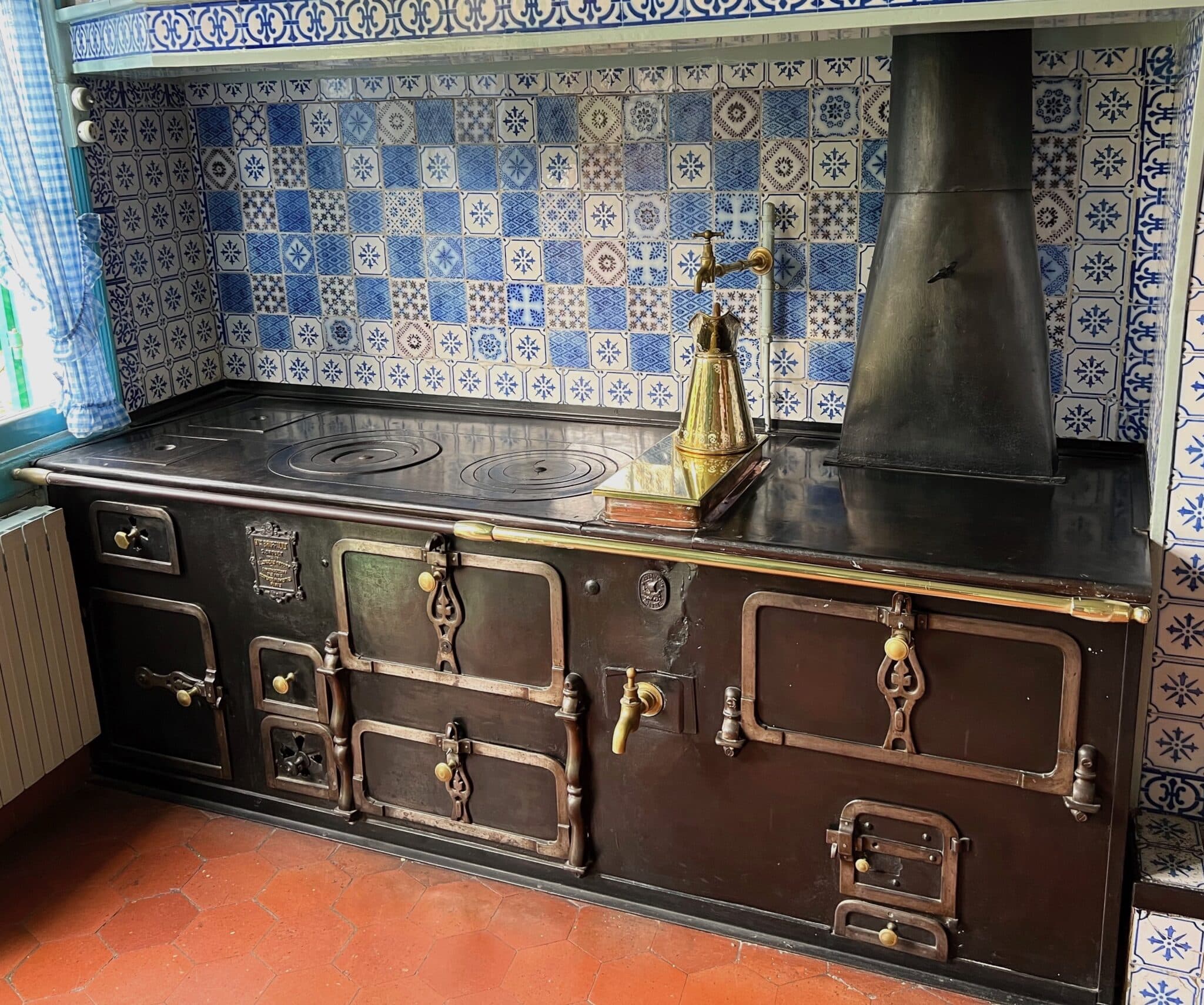
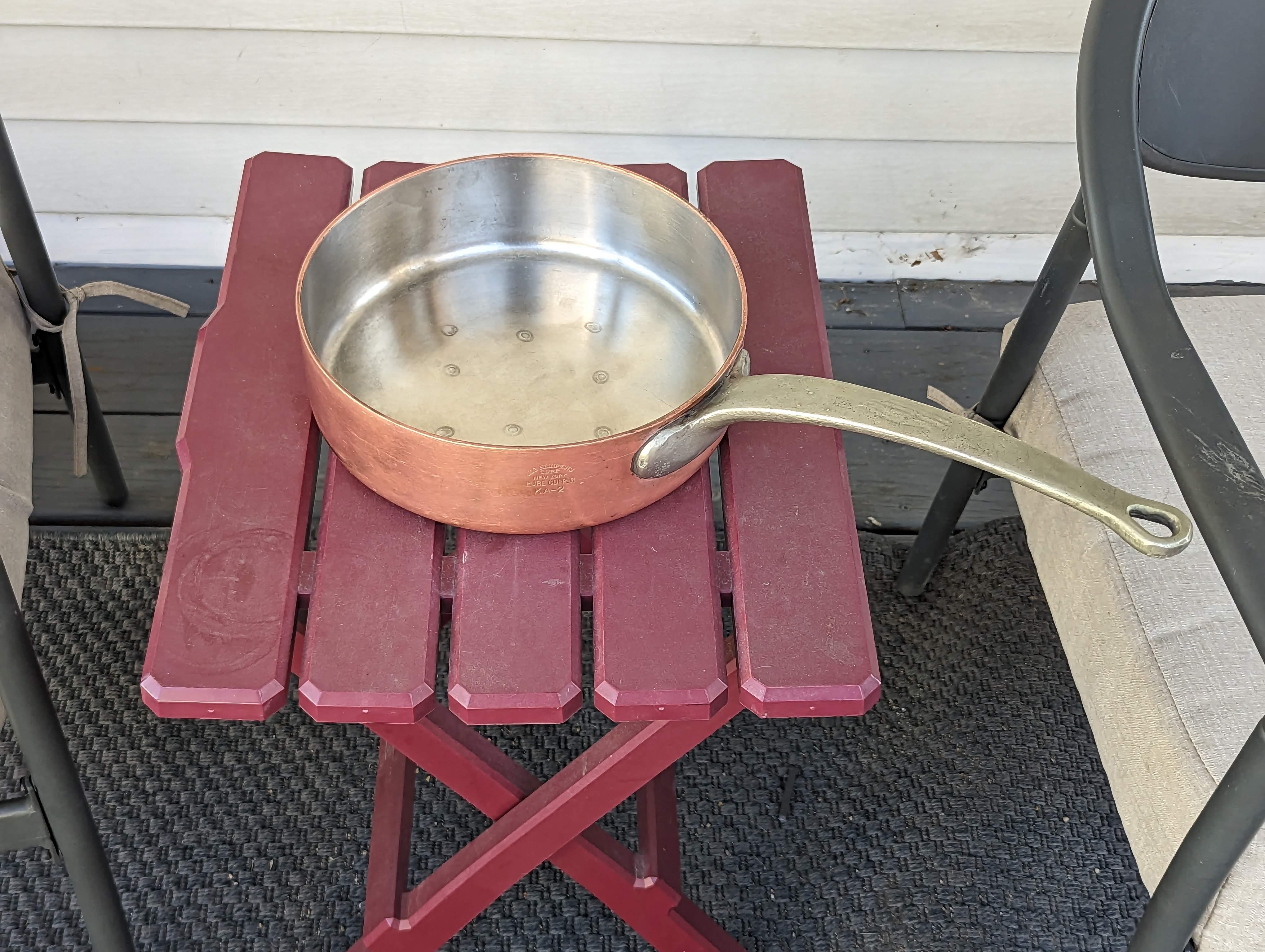
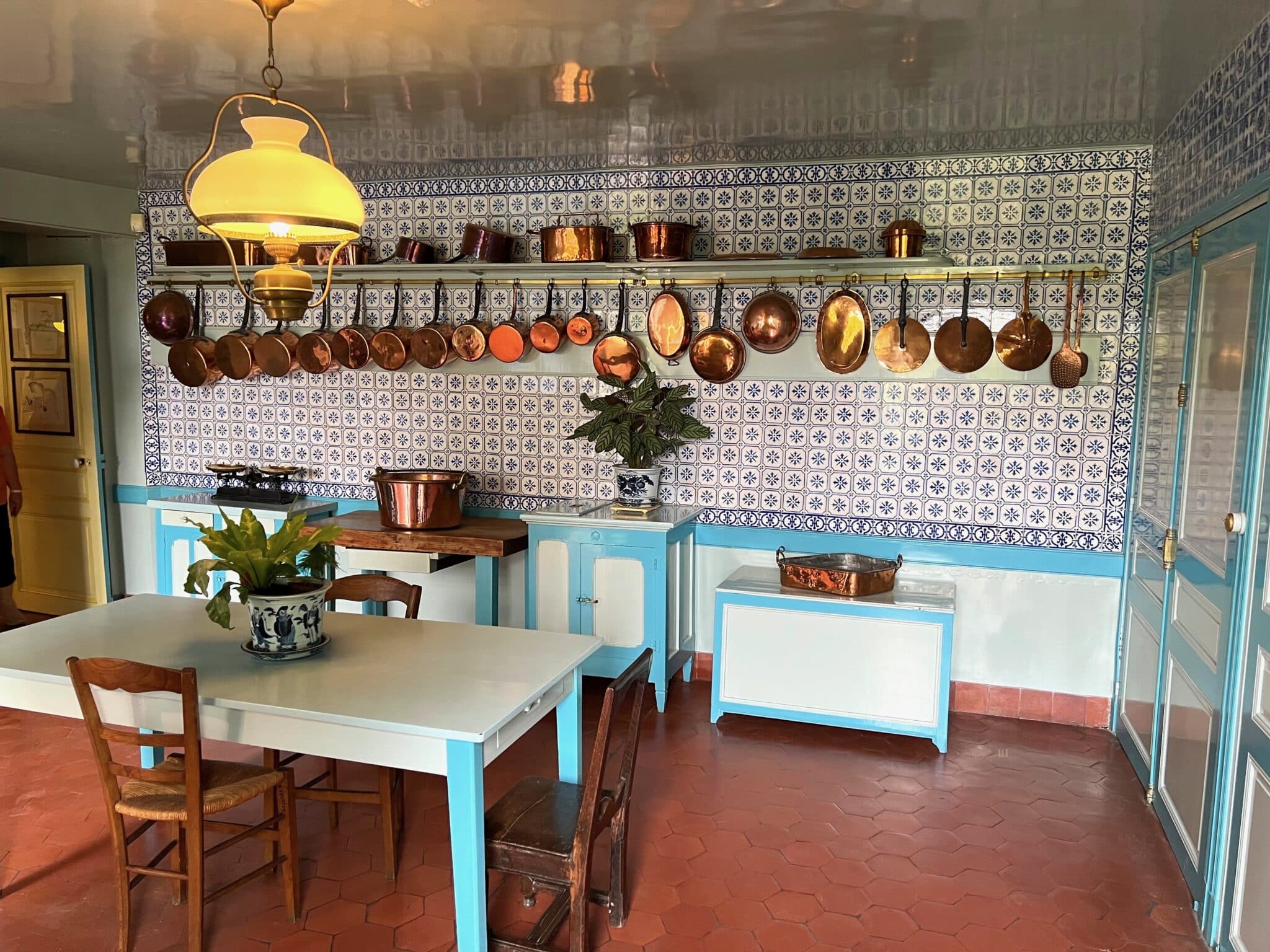
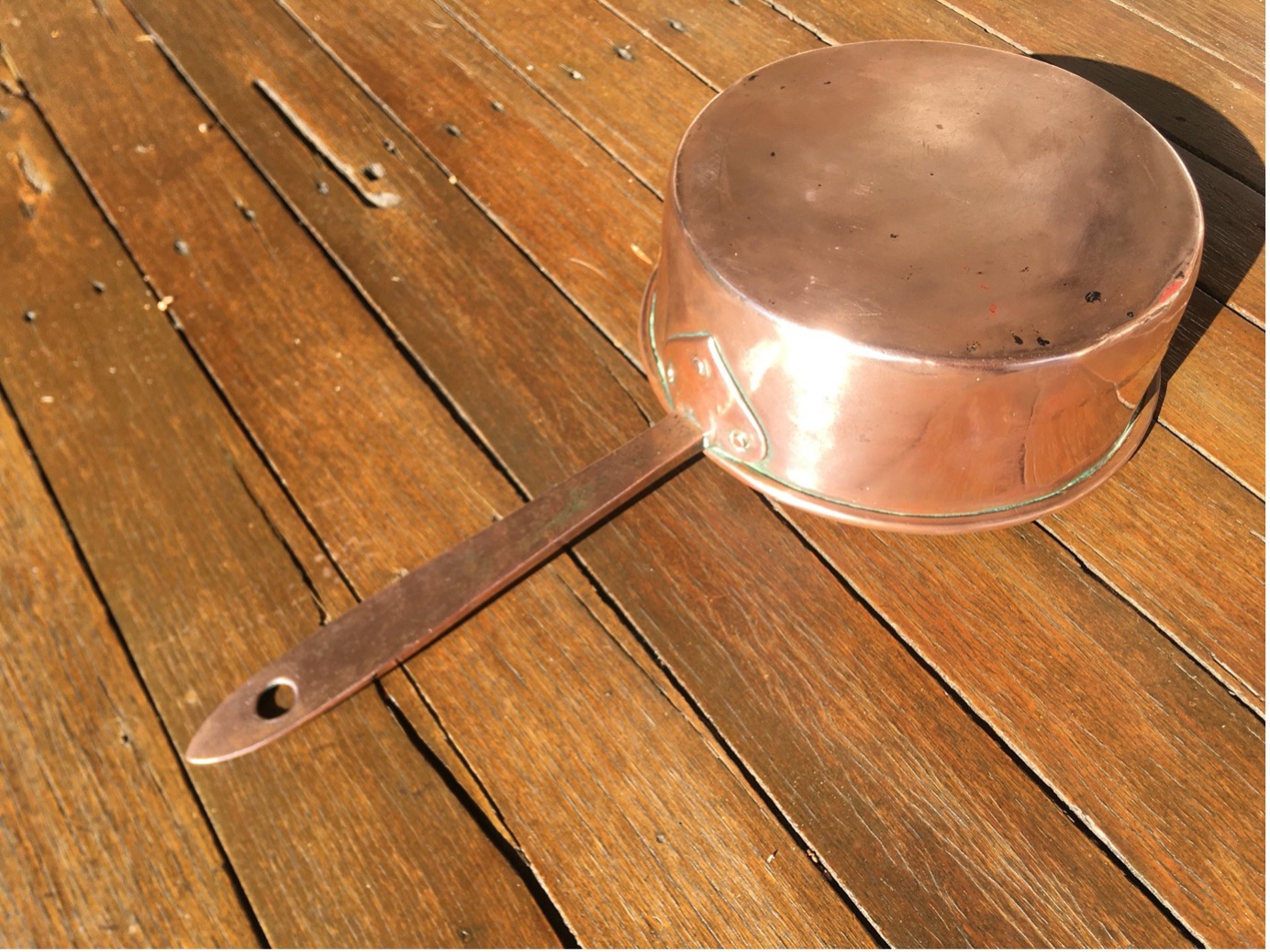
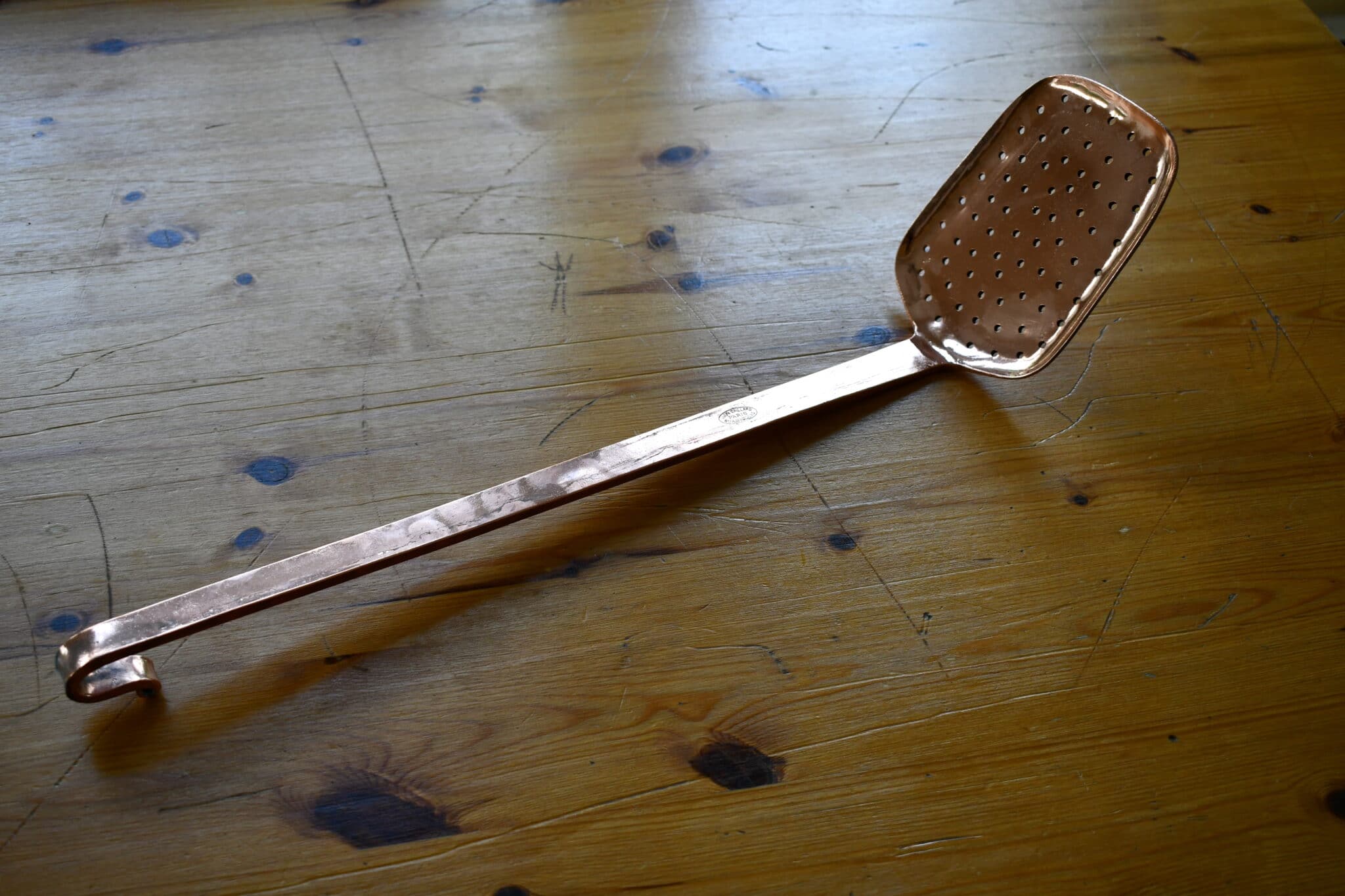
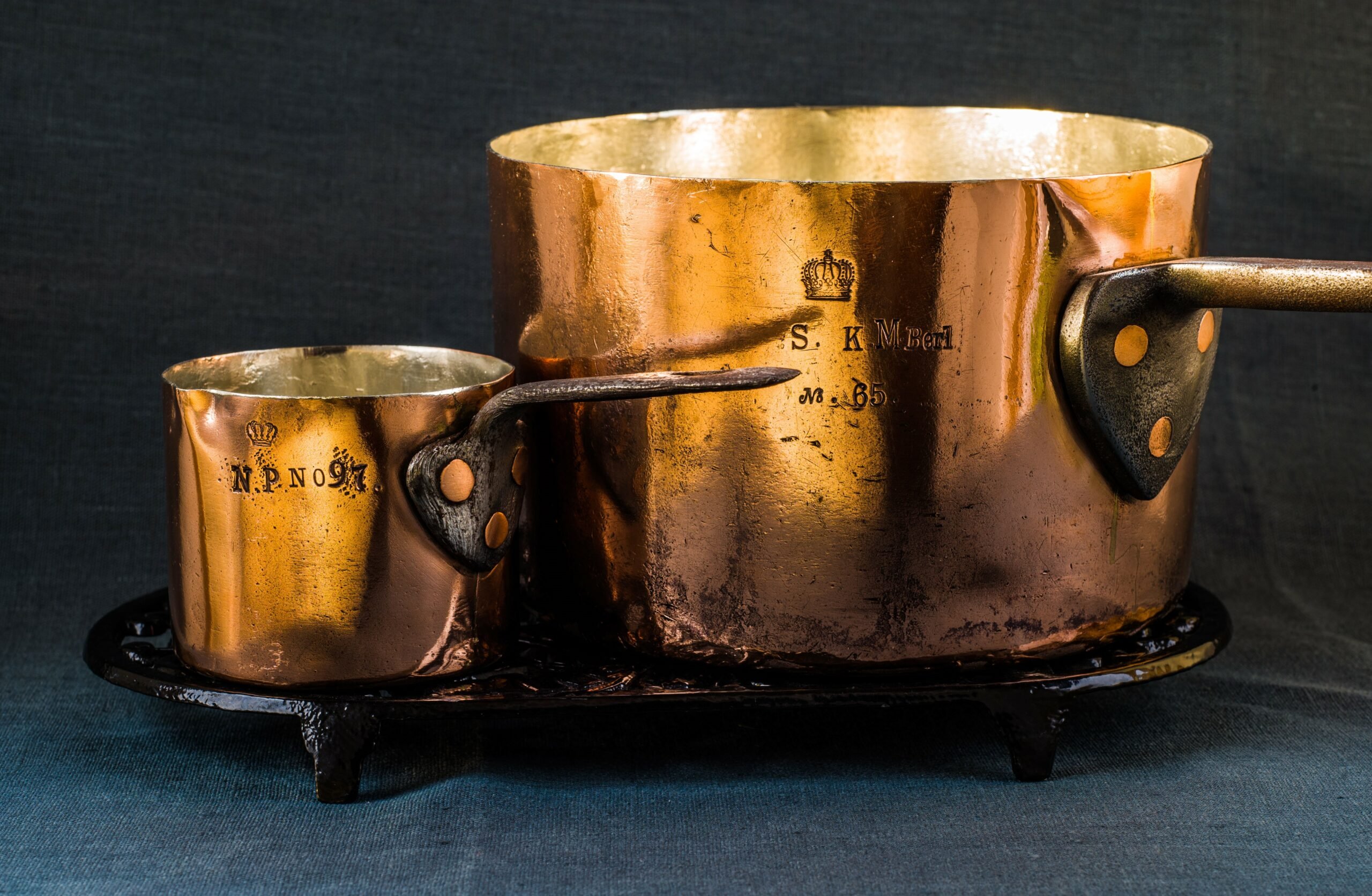
Loved this post! So informative and “begging” for us all to try this recipe and technique. Greatly appreciated.
Thank you Marjorie!
A really great kitchen report. I’ll take a day off and read through the post and hopefully understand it. Maybe I can manage my first own attempts in the evening. A good opportunity to use my little Pommes Anna for the first time. Thanks a lot for this.
Vive la pomme de terre!
Great post VFC! I purchased a pommes anna pan some time ago but have yet to use it. Your post has inspired me to dust it off and use it. Your experience and tips will be very helpful.
Hey Stephen! While using it I came to appreciate it for more than just Pommes Anna. They’re sturdy little things. The lid of the modern-era timbale is quite shallow but I imagine could be used to cook an egg or two or something like that.
Are starch or wax potatoes preferable? I grow some La Ratte and wonder if they would work.
Also, I imagine lower and slower would increase the delightfulness of the flavors and texture. I’ve seen versions of this recipe cook up to eight hours. The result is a crisp outside and a chewy delightfulness that yields to a soft pillowy center.
Hey Cameron! The antique era recipes all recommend “Dutch” potatoes or potatoes “from Holland,” and Julia Child recommends “boiling potatoes” — all references to waxy potatoes. And to your point about low-and-slow cooking — that may very well be how the recipe was conceived. Dubois recommends a “low oven.” Today the Pommes Anna recipes seem to call for 400 degree ovens and I wonder if this is to speed things up.
I enjoyed reading this both informed and entertaining history of the Pomme Anna. Thank you. However, I must point out the need for spelling corrections. French “pommes” are apples, “pomme de terre” are potatoes.
I have owned the modern form of the Pomme Anna pan, made by Mauviel, for many years. Inner diameter 15cm, height 6.5cm (with lid 6.8cm), diameter of lid (outer) about 18cm. Weight lower part 1,2kg, weight lid 770g; both made of 3mm thick copper. My Pomme Anna might be one of the least used pans in my kitchen. Simply because I have never really succeeded in this dish. First I couldn’t find convincing recipes and then my results looked nowhere near as nice as I had seen in some photos. Neither did I manage the delicate balance of crispiness and tenderness of the potato slices, nor did I achieve a reasonably acceptable aesthetic of the dish after lifting out or turning the potato cake. The result was more of a slipped pile of potatoes. But still, the potatoes had a delicate tenderness that I had not previously achieved in any other way. Potato gratins also have the combination of light crust and softness. But cooking in butter produces a much more delicate result than cooking in cream or broth.
I can confirm VFC’s experience and suggestions for improvement. The potato slices must be thin (1.5-2mm) and as uniform a size as possible. So when buying potatoes to pay attention to a suitable, rather elongated shape, otherwise you will have a lot of waste. The type of potatoes does not seem to be decisive. Watering and good rocking of the potato slices is mandatory. Each layer must be pressed (you should be able to find a flat object of suitable size in any kitchen).
Unfortunately, I have not yet found “my” recipe. Some recipes prepare the dish on the stove, others in the oven, still others combine stove (first) and oven. There is also disagreement as to whether the potato slices should be layered from the outside in or the inside out. Check out the perfect example of the dish at the top of the post. When this potato cake was toppled, the bottom layer must have been a small circle of slices in the center of the bottom of the pot. Then the next layer was a slightly larger circle. So here the slices were placed from the inside out.
In any case, this post is an incentive for me to give this dish another try.
It will probably remain a mystery why the creators of this dish chose the singular when naming it. Since the dish was dedicated out of reverence for a lady, the term “pomme d’amour” (love or candy apple) came to mind, where the singular was also chosen.
Every language has strange peculiarities. Even in Germany there is the term “Erdapfel” for potato, literally translated earth apple (or apple that grows in the ground). However, this term is hardly used today. When people order “Pommes” in our country, they mean French fries and don’t think for a second about apples.
Hey Martin! Yes indeed there is variation on the name of the pan (and the dish!). In the present day Dehillerin and Mauviel call it a “pomme anna” while Williams-Sonoma sells the very same Mauviel piece as “Pommes Anna.” I think the “Pommes Anna” spelling has caught on for the US market and we are accustomed to pronouncing it “pomezanna”, rhyming with “hosanna.” In historical French sources, I see the recipe named both ways, with and without the s; I have reproduced the quotes in the post as exactly as possible from the French sources and you can see the variations there. For example, Gouffé’s La livre de cuisine (1902 ed) calls the recipe “pommes de terre a l’étuvée dites Pommes Anna.” For this post I’ve adopted the US spelling for my own references to the dish and have preserved the spelling from source documents.
Excellent and engaging research and story. Why am I now SO hungry?
I’m happy to have one of the early Dehillerin Pommes Anna though its black with age and use.
Dear VFC, at first the spelling “Pomme Anna” as it can be read in the catalogs of our “demigods” Gaillard, Dehillerin and Mauviel was a bit strange to me, but I got used to it, adopted their spelling and would like to show my respect to the demigods 😉
And now I too have to actually use my pomme anna pan. I’m thinking of making a Rosti in it. Same concept of needing to flip it, yet it uses pre-boiled then shredded potatoes. That would eliminate some of the fuss of this dish, still tasting great.
A properly made Rosti will be crisp on all sides and soft on the inside, cut into slices and served with sour cream and cured salmon. Yea I’m giving it a try.
…I’ll still try a pomme anna too.
Cut off ends of potatoes and peel end to end. Slice 1/8″ thick. Peeling end to end let’s you shape the length of the potato into cylinders. Do the same with apples. The peeler can easily grab the end of the skin and peel in one stroke if you cut the ends off.
That looks painful work, your peeled potatoes. 🙂
I love this post! I’ve always been interested in this pan, as I’m a massive fan of potatoes and butter! (haha) Thank you for the interesting information on it’s history, and for sharing your experience cooking a pommes anna. The critique on Julia Child’s recipe is very helpful. When I finally get my hands on one of these beautiful pans I’ll refer back to this post. Your pommes anna looks like it came out delicious, and the pan provides a beautiful presentation. Thank you for a really great post as always, VFC! 🙂
One of your most delightful and well-researched articles, VFC and some lovely pans. I have a lovely Dehillerin Pomme Anna pan which I’m so glad I had the opportunity to acquire. Thanks for a wonderful read!
Thank you for this excellent article (as always). I just received a pommes anna pan and was hoping to find instructions on use; I was delighted to see vfc had an article.
I hope since your first try you’ve gone back to it again and perfected. I have been making pommes anna in cast iron for about 2 months based on a video on potatoes by the Argentine chef Francis Mallman. In that application I don’t fill the pan, nor add much butter (if any) BETWEEN the layers. (It is not a classic preparation.) The key (for me) is to slice the potatoes super thin. I cut by hand with a very sharp knife and aim for 1mm though I’m not perfect and some are 2mm. If I end up with thin shards on some cuts, I don’t worry; I just layer them in. The thin slices do two things: 1 helps avoid doming and 2 contact between pieces and layers is excellent because slices are flexible.
I only layer up to 2 cm and about 15 cm diameter. So there’s more ‘crisp’ than ‘pillow’ in this ratio. A spatula (or two) allow successful flipping (most of the time, not all). I cook them slowly over low heat, and covered, to get an even cook and browning.
With this 2cm preparation, it probably shouldn’t be called pommes anna, but I think the point about the ultra thin slices will help the classic. We’ll see… my pan is out for retinning… I have yet to face the moment of the fearful flip. 🙂
Great suggestion! Thank you.
To say it straight away, Pomme Anna has never looked as good to me as some of the results I’ve found online. But my experience so far confirms your ideas. I also cut the potato slices very thinly using a truffle or cheese slicer. I have probably always used too much butter. Perhaps I should also try your suggestion to reduce the height of the stack.
Thank you for the suggestions! I plan to try it again some day!